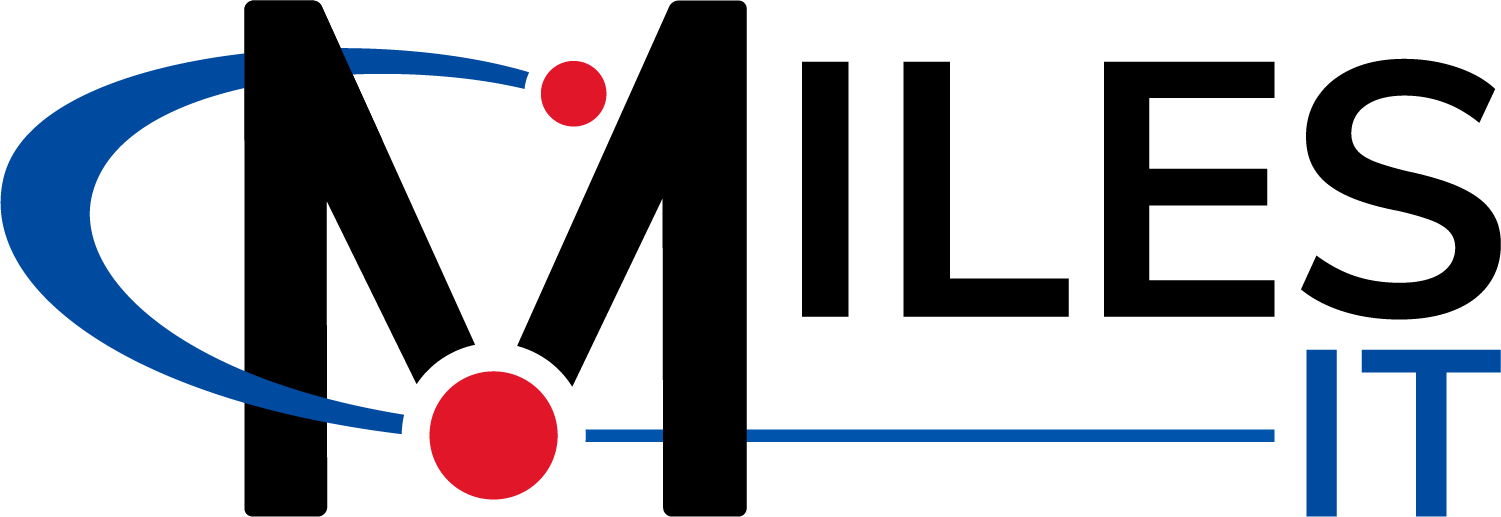Looking to estimate prices for your web portal project?
In this guide, we’ll explore how Miles IT approaches custom web portal pricing so you can estimate the cost of your proposed project.
Remember that this is a reference tool and your solution may end up aligning with a different price.
Keep reading to gain a deeper understanding of how tiered pricing maximizes results for your business in any proposed custom web portal development project.
Miles IT’s Tier Pricing Approach
At Miles IT, our software team utilizes tier-based pricing to categorize projects by their complexity, customization, and breadth of features & functionality.
What that means:
Complexity refers to the amount and level of different logic (such as calculations, business rules, and automation) within your software system.
Customization refers to the level of personalization required for a specific system.
For instance, adding a commonplace business process, like online discussion, to a system might not require significant complexity or customization.
But automating a nuanced business workflow requires much more work and effort. For example, a company that receives bids from subcontractors for particular aspects of a project may need a multi-step submission, review, and approval workflow.
The types of features and functionalities you’re looking to include matter, too.
Adding features that involve many users, lots of data, and multiple business processes will likely place your system in a higher-level tier.
Other factors that may influence your web portal tier include the usability and user experience (UX), integration types, reporting needs, security & compliance regulations, and technical requirements.
A small or Tier 0 web portal requires the least customization and complexity. It likely won’t have nuanced features or specific security & compliance requirements. This tier uses a no-code or low-code platform or plugin, which limits customization and the opportunity for expanded future capabilities.
As expected, these portals fall on the lower end of the price scale.
On the flip side, a Tier 5 portal would be an entirely custom system that supports expansive business needs. It may include portals or apps for multiple roles with interconnected workflows, data, and reporting.
Because of the in-depth features, reporting, and development work required, it falls on the higher end of the pricing scale.
Let’s explore each of these tiers in greater detail.
Small Tier (0) Web Portals
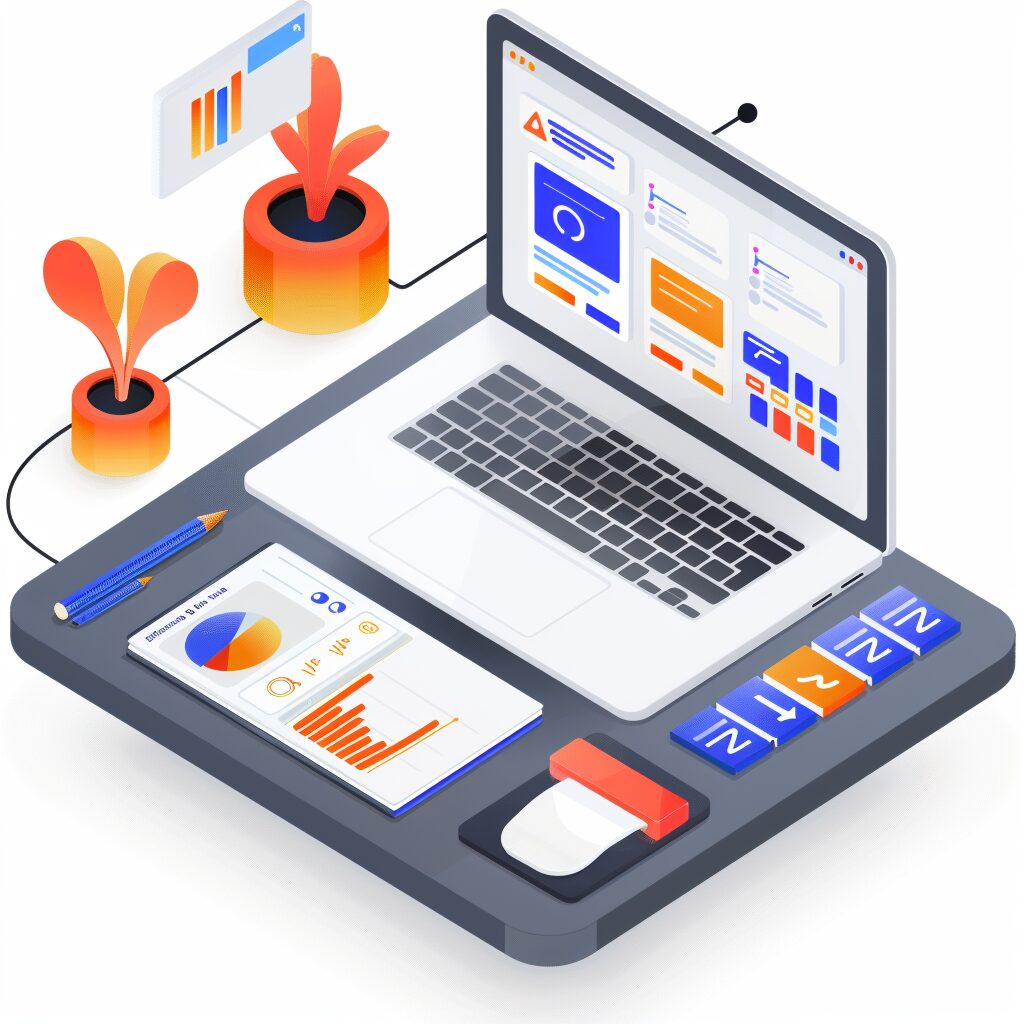
The Basics:
- Developed on pre-existing platforms
- Very simple; provides a limited feature set
- No or limited ability to customize
As the name suggests, small-tier web portals are basic and compact.
They’re not custom-built solutions; instead, they’re developed on pre-existing platforms, with additional plugins and scripting as needed.
Small-tier portals may focus on providing secure access to information. They typically don’t support complex business processes, workflows, or moving parts.
Consider this example of a Tier 0 web portal.
Say you took a certification test and wanted to view your results. The results are posted on a simple portal that allows you to view and download the information, but nothing more. If you needed to ask a question, you’d have to give the company a call or send an email.
This type of portal is a one-way communication system that shares real-time information as soon as it is available.
Depending on your needs, a basic web portal can cost as little as a few thousand dollars and rarely costs more than $25,000.
Overall, a small web portal is a great choice if you’re looking for a simple solution with standard configuration and capabilities.
Tier 1 Web Portals
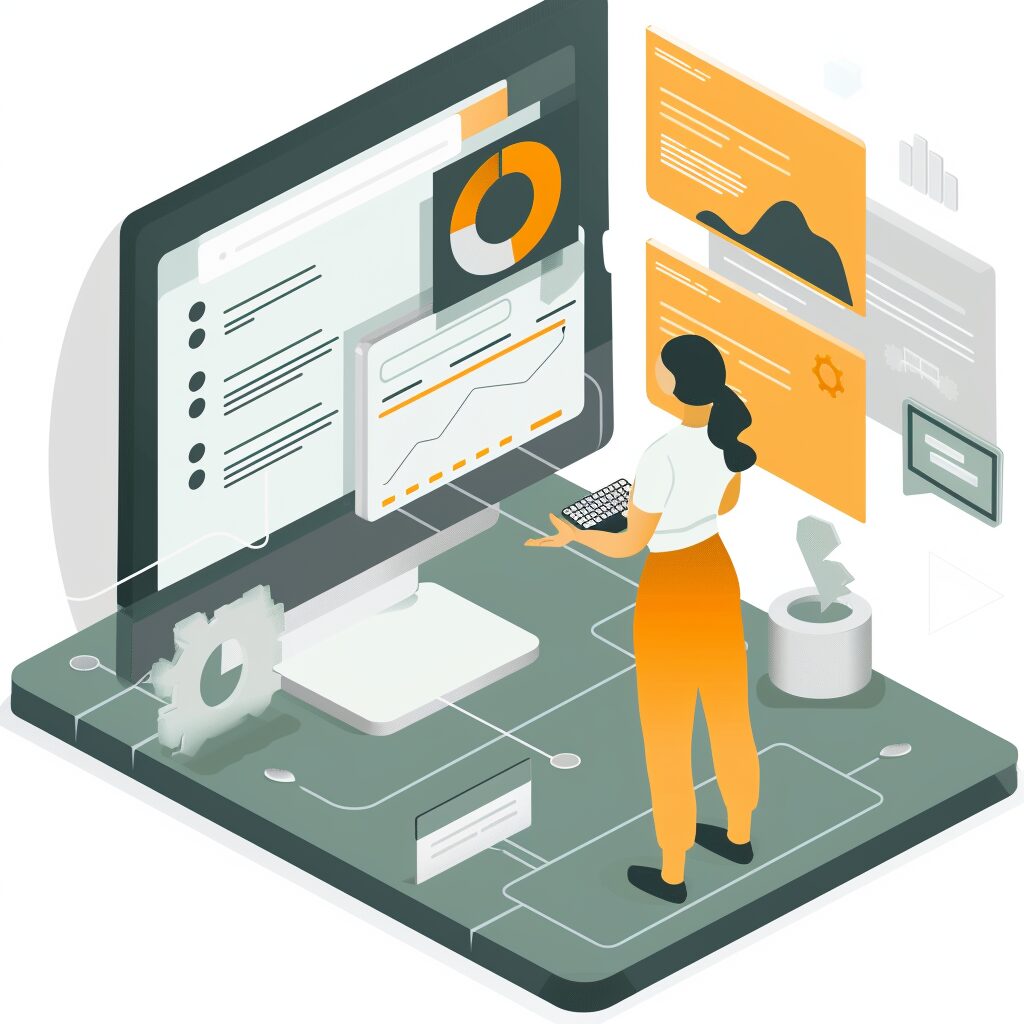
The Basics:
- Supports one or two core custom business processes
- Doesn’t handle complex workflows or reporting
Tier 1 web portals are one step up from small portals in terms of features and functionality.
These custom-built solutions typically support one or two core business processes.
Unlike small-tier web portals, they allow for interface and communication between different parties—the two-way exchange of information.
This may include sharing files, sending messages, reviewing information, and more. However, these portals are typically focused on supporting 1 to 2 roles in an organization.
Consider this example of a Tier 1 web portal.
Let’s say you own a restaurant. You need to organize your inventory, but with so many different vendors, it’s becoming difficult to handle.
You decide to create a web portal that lets your vendors submit orders and communicate about shipping times, delivery status, and more. The portal also lets the vendors send simple communications when necessary.
Tier 1 solutions don’t need to handle complex estimating workflows or reporting, but they do allow for real-time vendor communication.
Tier 1 web portals will typically range from $25,000 to $50,000.
If you’re looking for a basic portal to improve or automate a few workflows and enable 24/7 interactions, a Tier 1 solution might be right for you.
Tier 2 Web Portals
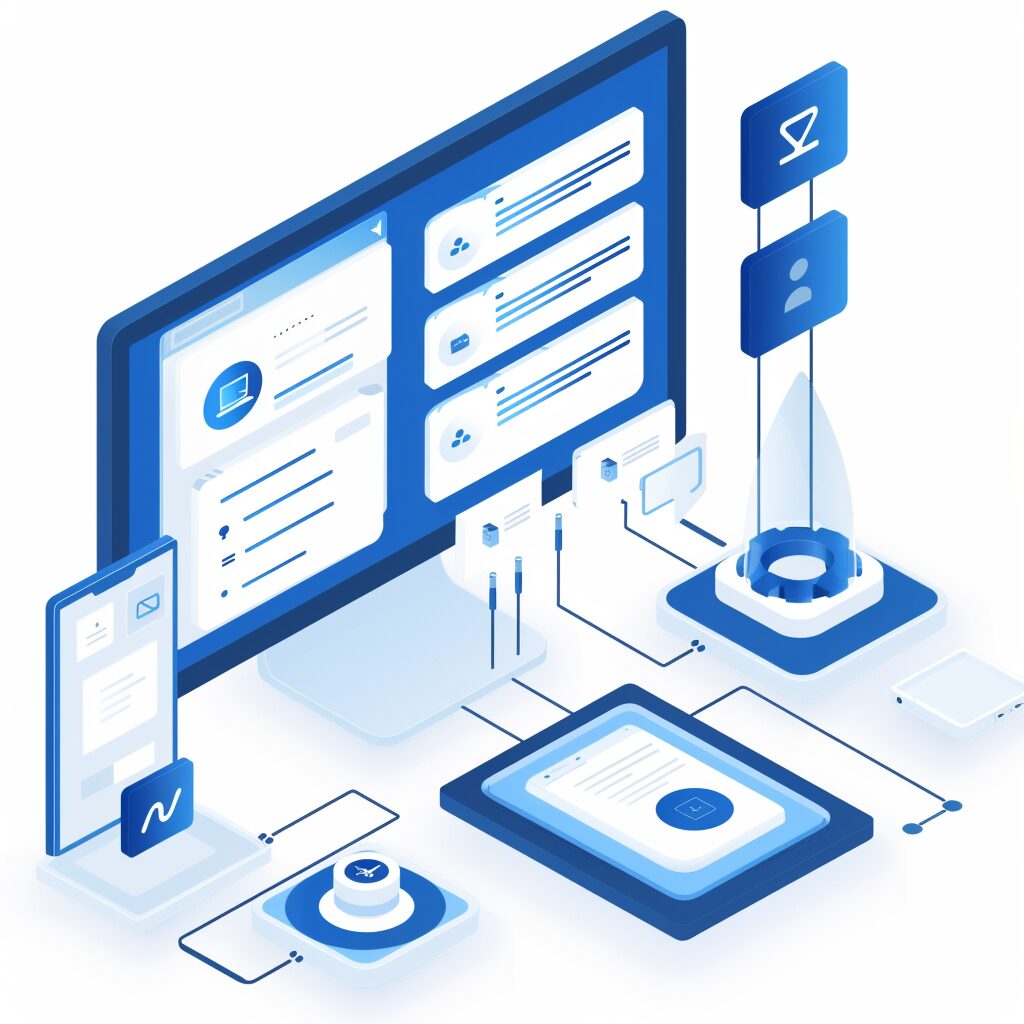
The Basics:
- Supports a limited number of business workflows
- Well-defined, simple logic with minimal complexity
Tier 2 web portals are moderate in price and function, falling in between the focused approaches of small and Tier 1 portals and the expansive functionalities of Tier 3, 4, and 5 portals.
This type of custom-built portal is a great choice if you’re looking to support a specific number of business workflows and processes.
Overall, these systems allow for workflow automation with outside parties and have well-defined, simple logic without much complexity.
Consider this example of a Tier 2 web portal.
Say you’re a service provider working with organizations to share the status of service visits and ensure clients pay their bills on time and in full.
To make the job easier and more efficient for your team, you could create a web portal that displays all required payments per client. Then, the portal can record all associated client activity, including appointment records, billing statements, and phone requests.
Your clients no longer need to call or email your customer service team regarding billing. Instead, they can access the portal for updated data and easy-to-understand recordkeeping. Helpful reporting tools, like dashboards and graphics, can be big time-savers when incorporated.
Diverse functionalities, integrations, and nuances make this portal a true example of a Tier 2 solution.
Typically, Tier 2 portals cost between $50,000 and $100,000.
If you’re looking for a portal with a moderate level of functionality, Tier 2 may be a good starting point.
Tier 3 Web Portals

The Basics:
- Serves multiple core needs of a small business or department
- Supports custom workflows and business processes with moderate complexity
As we move into Tier 3 portal solutions, we start to see higher levels of functionality and customization.
These portals are characterized by their ability to serve multiple core needs of a small business or a department in a larger organization.
Consider this example of a Tier 3 portal.
Say that you own a painting company. With many prospects seeking quotes, you decide to build a custom portal that helps send out quotes, create contracts, and manage customer data and approval workflows.
With the help of the portal, you can easily convert quotes into orders while automating processes related to projects, customer contracts, and financial information.
Plus, you can also organize information about your painting crew, project statuses, and marketing details.
In addition, your portal might incorporate optional features like communications, dashboards, and third-party system integrations.
Typically, Tier 3 portals range from $100,000 to $200,000.
You may want to consider Tier 3 if you’re a large business looking to streamline a specific department or a smaller company looking to improve processes.
Tier 4 Web Portals
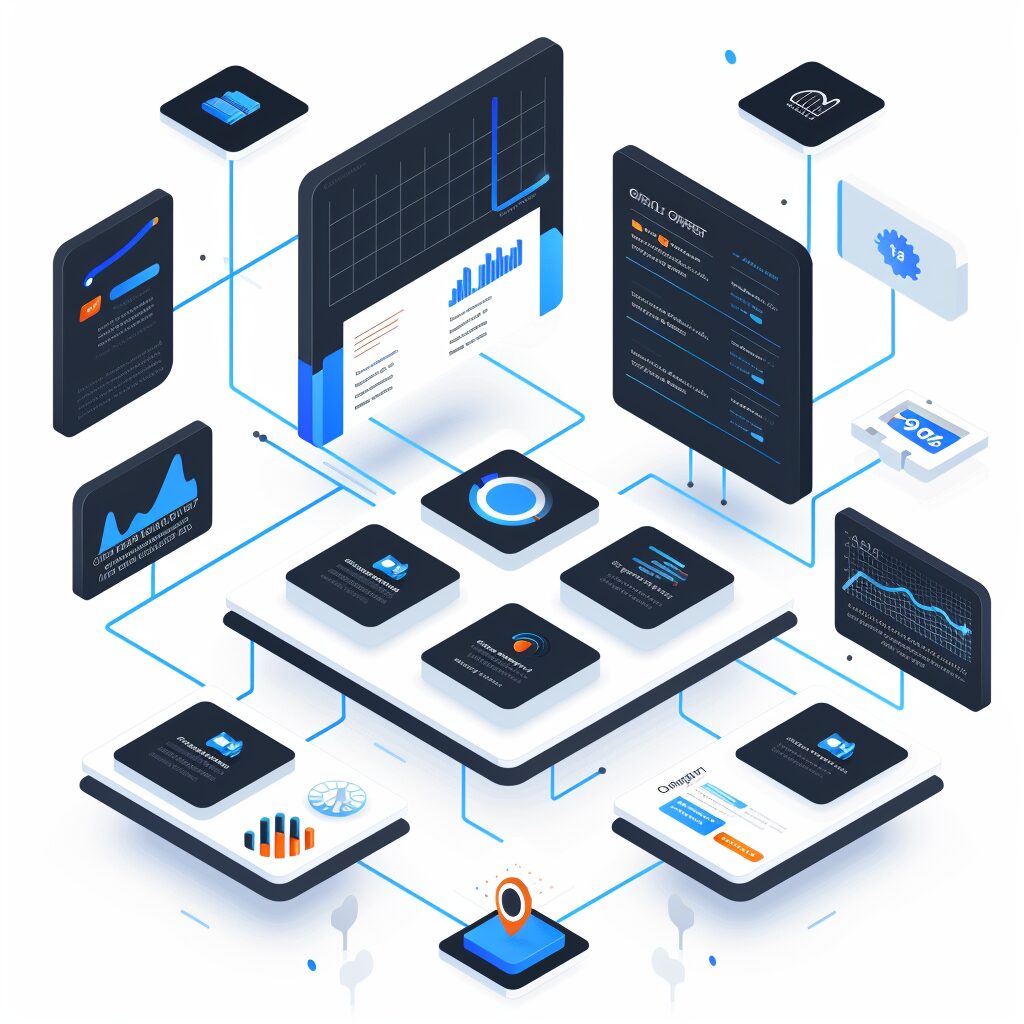
The Basics:
- Supports greater needs of businesses
- May include multiple portals or apps as part of the project
- Has complex logic; may include multiple integrations
Tier 4 web portals have a wide range of functionality to support the more comprehensive needs of small- or medium-sized businesses or multiple areas of a larger organization.
These solutions are characterized by complex logic, multiple integrations, and standard and ad-hoc reporting.
Highly customized to a particular business’s needs and workflows, they often handle core business functions at the enterprise level.
They often include multiple portals and apps for different roles or partners as part of the solution to ensure it has all the functionality it needs.
Consider this example of a Tier 4 solution.
Let’s say you own a manufacturing company. You’ll likely need to work closely with multiple parties like distributors, dealers, and consumers to ensure goods move through the appropriate channels.
As a result, you might choose to build a solution with multiple portals.
That way, you can enable interactions among each of the different groups to streamline processes and simplify communication. The portals also may need to integrate with your ERP or other external systems to help automate the business processes handled in your portal.
A Tier 4 portal would fit this type of scenario because it allows for interactions among multiple different parties—and gives them the tools to enable those interactions.
Typically, Tier 4 solutions range in cost from $200,000 to $400,000, depending on the customization, level of complexity, and workflow logic.
Tier 5 Web Portals
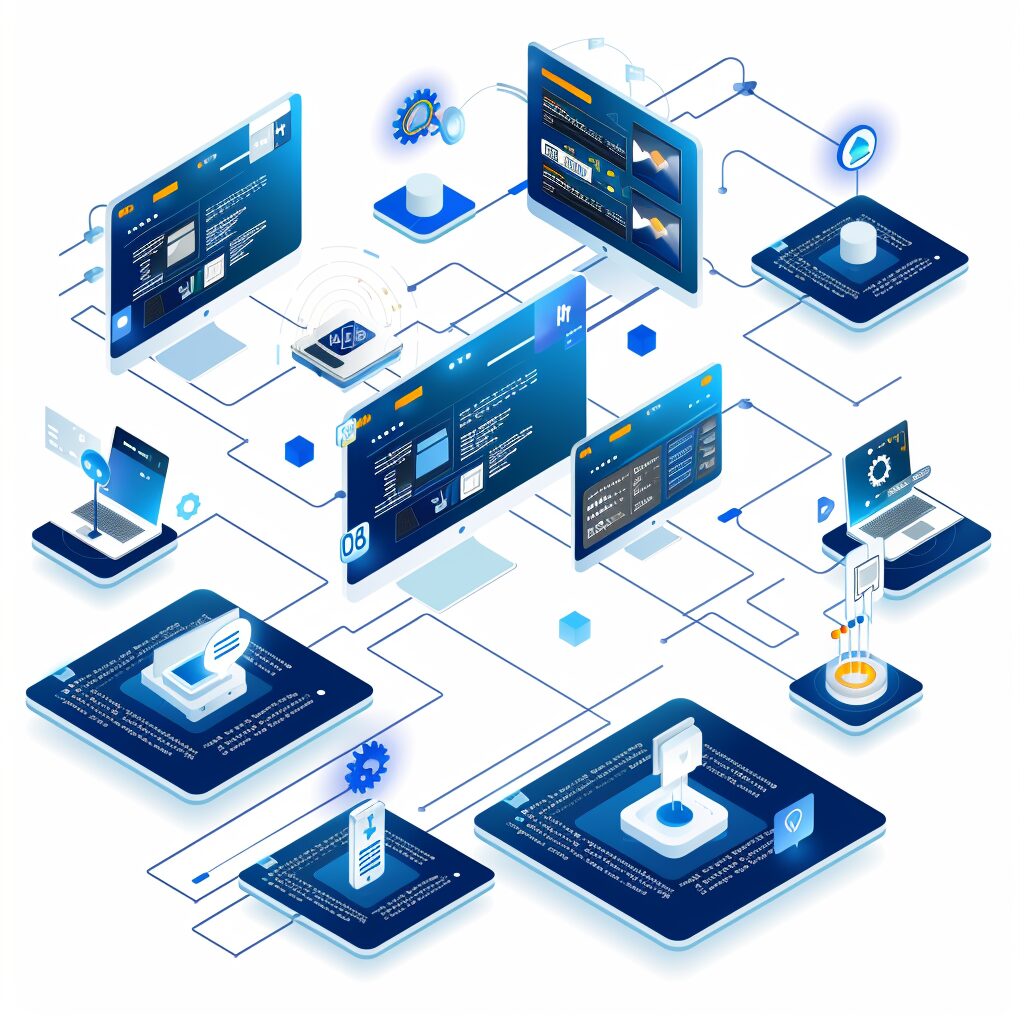
The Basics:
- Supports various needs of a medium-sized or large business
- Highly complex logic with multiple portals or apps
- Extensive features and may support complex compliance or user experience needs.
Tier 5 web portals are Miles IT’s most complex web portal solutions. They have an extremely advanced range of features and functionality and can fully support the needs of a medium or large business.
With Tier 5 portals, logic is highly complex and often includes multiple portals or apps.
These portals likely require complex technical architecture, advanced integrations, and extensive features that go well beyond the basics.
Additionally, they may have advanced security and compliance requirements, like HIPAA.
Consider this example of a Tier 5 web portal.
Say that you run a private practice to contract out medical and social services. You might create a web portal that allows you to easily share information with other medical practitioners and insurance companies while maintaining strict HIPAA compliance.
You may also need to create portals for the medical and social service professionals to build their schedules, track their appointments, and appropriately bill the right parties. A patient portal could provide relevant medical, appointment, and billing history.
You might also decide to build an app so that the professionals can easily track their time and appointments.
This is exactly what a Tier 5 web portal looks like: highly interconnected and complex. They help streamline interactions between multiple different internal and external parties while adhering to important security and legal requirements.
Due to their highly complex nature, Tier 5 web portals typically cost $400,000 or more.
Summary Chart
There are three main factors to consider when it comes to the tier that best fits your web portal project:
- Breadth of features & functionality
- Level of complexity
- Level of customization
Higher tiers give you more features, more complexity, and more customization.
These components may include:
- Multiple portals
- Additional integrations
- Advanced workflows
- Support for complex compliance requirements
- Highly customized user experiences and functional needs
The specific features available for your portal won’t be tied to any individual tier. However, layering more of these elements will move you from Tier 1 through Tier 5.
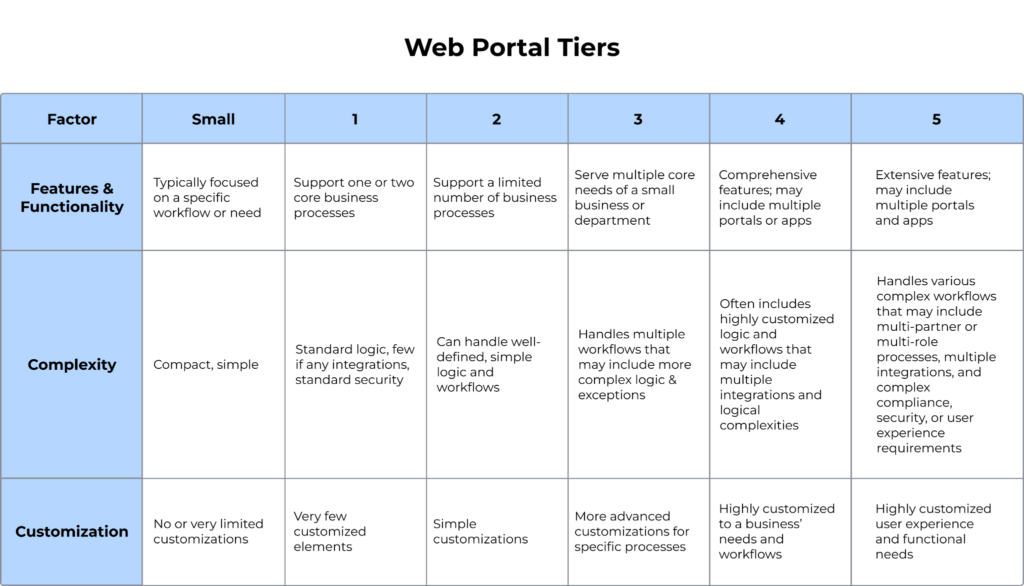
Additional Web Portal Considerations
As you turn your web portal vision into reality, you’ll want to keep other factors in mind.
Ensure Continual Support
Beyond considering the price of developing your web portal, you should plan for ongoing support costs.
All technology needs to be maintained and updated over time, and web portals are no different.
Whether you build a Tier 1 or Tier 5 portal, you will need to budget for support and hosting costs.
If something stops working or you have a question, you’ll want to be sure that you can get immediate assistance and clarification.
Be sure to work these costs into your overall budget in order to keep your system secure.
Start Small, Then Expand
Some businesses start simple and enhance their solution over time. By using this approach, you create a strong foundation that allows you to incorporate advanced functionality as necessary.
Seeing your solution in practice may help reveal the additional features you need. Or you may realize that you don’t need certain functionalities after all.
By starting with your Minimum Valuable Product, you can get a return on investment faster and gain a deeper understanding of your solution.
You may have heard of the term Minimum Viable Product, where you focus on creating a product with the bare minimum of features and functionality. This approach lets you gauge interest and usability before making a huge investment.
However, we use the term Minimum Valuable Product at Miles IT. We feel that every investment should expect a sensible but valuable return, ensuring that the development work and resulting solution make a worthwhile impact.
Focus on Value
Always take a value-driven approach to your solution!
Prioritize the features and items that will have the greatest impact on your people, processes, and overall business.
If a certain feature no longer seems essential, consider deprioritizing it. There’s no sense in investing time and energy into a certain functionality that is not as relevant anymore.
Building a Successful Portal
Now that you have a better idea of the different solution tiers available, you can more accurately plan a budget for your software project.
Remember that the complexity and customization of your portal often determine cost, so keep that in mind when deciding which features are critical to success.
Ready to create your custom solution? Reach out to our team to book a consultation and discuss your specific needs in more detail.
